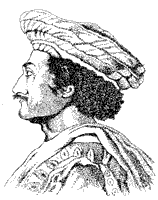 A Bengali by birth, Raja Ram Mohan Roy (1772 - 1833) triggered the religious, social, cultural and educational reforms in India. He was a pioneer in show casing the lines of progress of Indian society under British rule. He challenged the traditional Hindu culture and initiated the Bangal renaissance. The social and cultural awakening of India started with Ram Mohan Roy and through his Brahma Samaj. Because of all this he is considered as the first modern man of India.
Below given are the major events in his life
A Bengali by birth, Raja Ram Mohan Roy (1772 - 1833) triggered the religious, social, cultural and educational reforms in India. He was a pioneer in show casing the lines of progress of Indian society under British rule. He challenged the traditional Hindu culture and initiated the Bangal renaissance. The social and cultural awakening of India started with Ram Mohan Roy and through his Brahma Samaj. Because of all this he is considered as the first modern man of India.
Below given are the major events in his life
Raja Ram Mohan Roy - Social Reformer
1. Ram Mohan Roy learned English from the English missionary William Carey who settled in India to translate, publish and distribute the Bible in Indian languages and propagate Christianity to the Indian peoples.
2. Along with Carey and Tantric Hariharananda Vidyabagish, Roy fabricated a spurious religious work known as the "Maha Nirvana Tantra" (or "Book of the Great Liberation") and attempted to portray it as an ancient religious text to "the One True God", which was actually the Holy Spirit of Christianity masquerading as Brahma.
3. From 1803 till 1815, Rammohan served the East India Company's "Writing Service", commencing as private clerk (munshi).
4. In 1815, Raja Ram Mohan Roy formed Atmiya Sabha. Atmiya Sabha tried to initiate social and religious reforms in the society. Raja Ram Mohan Roy campaigned for rights for women, including the right for widows to remarry, and the right for women to hold property. He actively opposed Sati system and the practice of polygamy.
5. Sambad Kaumudi was the first Bengali weekly newspaper published from Kolkata in 1821 by Ram Mohan Roy. It was a noted pro-Reformist publication that actively campaigned for the abolition of the Sati. In 1822, Ram Mohan published Mirat-ul-Akbar in Persian language.
6. In 1817, in collaboration with David Hare, he set up the Hindu College at Calcutta. Roy founded the Anglo-Hindu school in 1822, followed by the Vedanta College in 1826, where he insisted that his teachings of monotheistic doctrines be incorporated with "modern, western curriculum".
7 Roy demanded property inheritance rights for women and, in 1828, set up the Brahma Sabha, which was a movement of reformist Bengalis formed to fight against social evils.
8. Roy is most remembered for helping Lord William Bentinck to declare the practice of Sati a punishable offense in 1829.
9. Roy was an ambassador of the Mughal emperor Akbar II, who conferred on him the title of Raja to convince the British government for welfare of India and to ensure that the Lord Bentick's regulation banning the practice of Sati was not overturned.
10. Roy died at Stapleton,Bristol in 1833 due to meningitis.





0 comments: